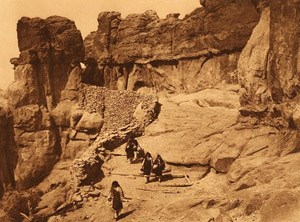
San Estevan del Rey Mission Church
Acoma Pueblo, New Mexico
Coordinates: 34.97584,-107.63223
#TravelSpanishMissions
Discover Our Shared Heritage
Spanish Colonial Missions of the Southwest Travel Itinerary

Photo by Edward S. Curtis (1868-1952). Courtesy of Library of Congress.

Photo by Ansel Adams (1902-1984). Courtesy of U.S. National Archives.

Photo by Marshall Henrie. Courtesy of Wikimedia Commons.

Photo by Jsweida. Courtesy of Wikimedia Commons
Plan Your Visit
Acoma is a National Historic Landmark located on Acoma Rock, on NM Route 23, 13 miles south of Casa Blanca, NM. Click here for the Acoma National Historic Landmark file: text and photos. Tours of Acoma are available through the Haa’ku Museum and Sky City Cultural Center. Hours and admission costs vary. For more information, visit the museum’s website or call 1-800-747-0181.
Both Mission San Estevan del Rey and the Acoma Pueblo have been documented by the National Park Service’s Historic American Buildings Survey. Acoma is also featured in the National Park Service American Southwest Travel Itinerary and American Latino Heritage Travel Itinerary.
Last updated: April 15, 2016
